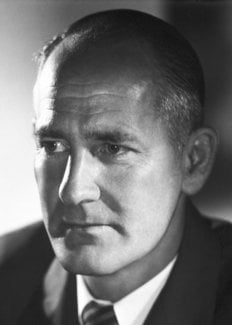George Beadle
Biographical

George Wells Beadle was born at Wahoo, Nebraska, U.S.A., October 22, 1903, the son of Chauncey Elmer Beadle, a farmer, and his wife Hattie Albro. George was educated at the Wahoo High School and might himself have become a farmer if one of his teachers at school had not directed his mind towards science and persuaded him to go to the College of Agriculture at Lincoln, Nebraska. In 1926 he took his B.Sc. degree at the University of Nebraska and subsequently worked for a year with Professor F.D. Keim, who was studying hybrid wheat. In 1927 he took his M.Sc. degree, and Professor Keim secured for him a post as Teaching Assistant at Cornell University, where he worked, until 1931, with Professors R.A. Emerson and L.W. Sharp on Mendelian asynopsis in Zea mays. For this work he obtained, in 1931, his Ph.D. degree. In 1931 he was awarded a National Research Council Fellowship at the California Institute of Technology at Pasadena, where he remained from 1931 until 1936. During this period he continued his work on Indian corn and began, in collaboration with Professors Th. Dobzhansky, S. Emerson, and A.H. Sturtevant, work on crossing-over in the fruit fly, Drosophila melanogaster.
In 1935 Beadle visited Paris for six months to work with Professor Boris Ephrussi at the Institut de Biologie physico-chimique. Together they began the study of the development of eye pigment in Drosophila which later led to the work on the biochemistry of the genetics of the fungus Neurospora for which Beadle and Edward Lawrie Tatum were together awarded the 1958 Nobel Prize for Physiology or Medicine.
In 1936 Beadle left the California Institute of Technology to become Assistant Professor of Genetics at Harvard University. A year later he was appointed Professor of Biology (Genetics) at Stanford University and there he remained for nine years, working for most of this period in collaboration with Tatum. In 1946 he returned to the California Institute of Technology as Professor of Biology and Chairman of the Division of Biology. Here he remained until January 1961 when he was elected Chancellor of the University of Chicago and, in the autumn of the same year, President of this University.
During his career, Beadle has received many honours. These include the Hon. D.Sc. of the following Universities: Yale (1947), Nebraska (1949), Northwestern University (1952), Rutgers University (1954), Kenyon College (1955), Wesleyan University (1956), Birmingham University and Oxford University, England (1959), Pomona College (1961), and Lake Forest College (1962). In 1962 he was also given the honorary degree of LL.D. by the University of California, Los Angeles. He also received the Lasker Award of the American Public Health Association (1950), the Dyer Award (1951), the Emil Christian Hansen Prize of Denmark (1953), the Albert Einstein Commemorative Award in Science (1958), the Nobel Prize in Physiology or Medicine 1958 with E.L. Tatum and J. Lederberg, the National Award of the American Cancer Society (1959), and the Kimber Genetics Award of the National Academy of Sciences (1960).
He is a member of several learned societies, among which the National Academy of Sciences (Chairman of Committee on Genetic Effects of Atomic Radiation), the Genetics Society of America (President in 1946), the American Association for the Advancement of Science (President in 1955), the American Cancer Society (Chairman of Scientific Advisory Council), the Royal Society of London, and the Danish Royal Academy of Science.
Beadle has married twice. By his first wife he had a son, David, who now lives at The Hague, the Netherlands. His second wife, Muriel McClure, a well-known writer, was born in California. Beadle’s chief hobbies are rockclimbing, skiing, and gardening.
This autobiography/biography was written at the time of the award and first published in the book series Les Prix Nobel. It was later edited and republished in Nobel Lectures. To cite this document, always state the source as shown above.
George Beadle died on June 9, 1989.
Nobel Prizes and laureates
Six prizes were awarded for achievements that have conferred the greatest benefit to humankind. The 14 laureates' work and discoveries range from quantum tunnelling to promoting democratic rights.
See them all presented here.
